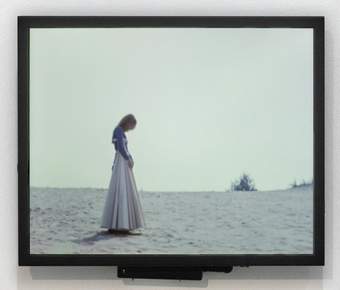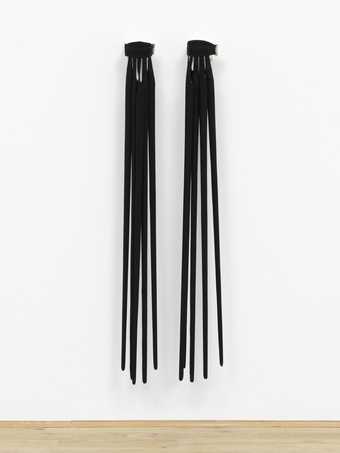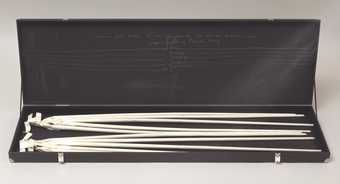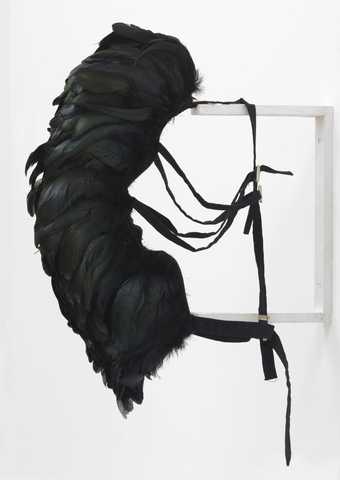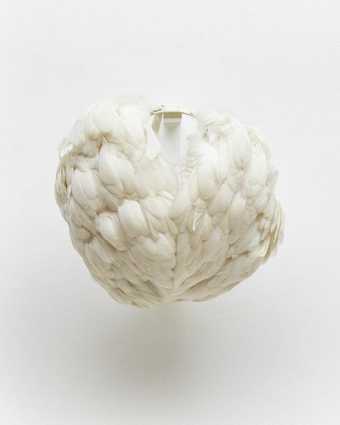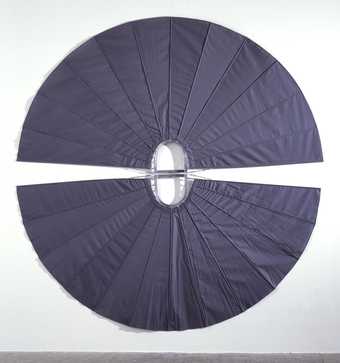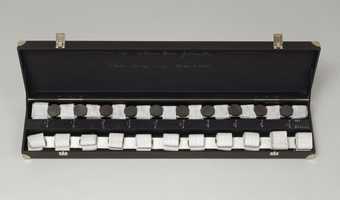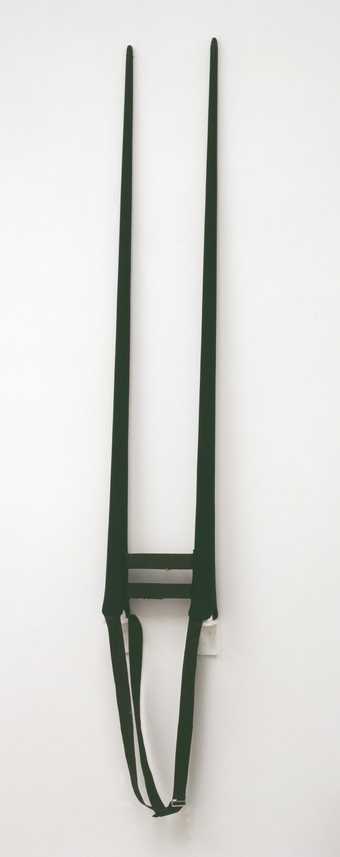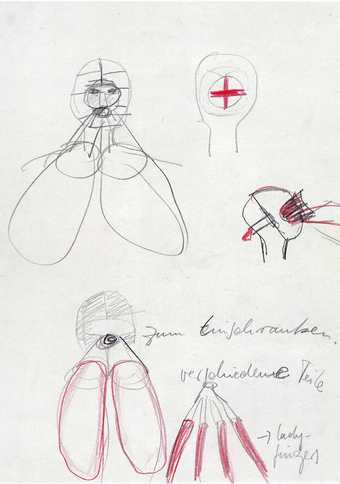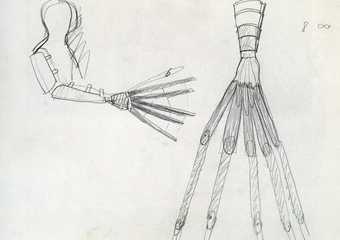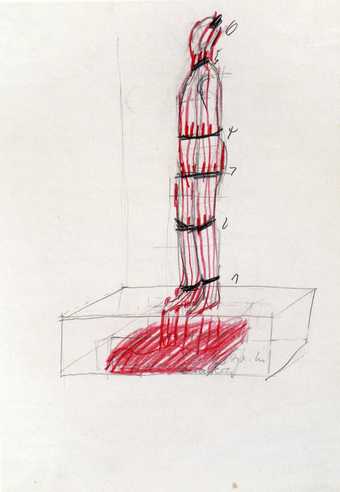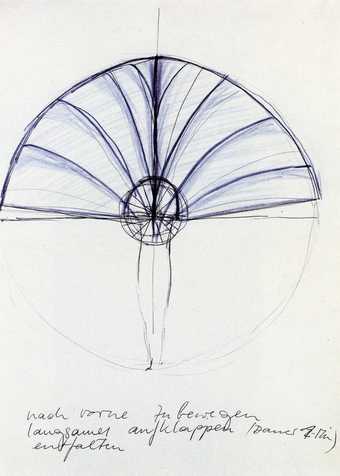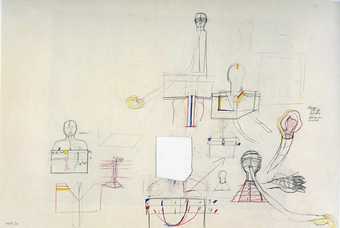
Not on display
- Artist
- Rebecca Horn born 1944
- Original title
- Berlin übungen in neun Stücken: Unter dem Wasser schlafen und Dinge sehen, die sich in weiter Ferne abspielen
- Medium
- Film, 16mm, shown as video, colour and sound
- Dimensions
- Collection
- Tate
- Acquisition
- Presented by the artist 2000
- Reference
- T07625
Summary
Berlin Exercises: Dreaming under Water 1974–5 is a colour film, shown as a video, consisting of a series of performance works enacted by one or two people for the camera. The film is divided into segments, introduced by the title of each individual performance in English (the text below uses different English translations, corresponding to those given in the artist’s filmography: http://www.rebecca-horn.de/pages/filmography.html, accessed 10 June 2016). The performances focus on interventions on the human body, sometimes featuring garment-like sculptures worn by the performers, and are set in a single interior: a room with two windows, unfurnished except for a mirror and occasional props.
In ‘Touching the walls with both hands simultaneously’ Horn is seen wearing a pair of white gloves with elongated fingers (see Finger Gloves 1972, Tate T07845), extending her reach to the exact width of the room as she walks back and forth on its central axis. The sound of her gloves scratching the walls is amplified in the soundtrack. In ‘Blinking’, the artist shares the room with a white cockatoo and imitates its behaviour by covering one eye, winking and emitting loud sounds. The cockatoo, fairly indifferent to her, moves around the room and interacts with the mirror. In ‘Feathers dance on the shoulders’, a female performer wears a shoulder-mounted apparatus with brown-spotted feathers attached to strings that she pulls with her feet (see Tate T07852). As she dances to Renaissance music, the feathers move up and down rhythmically following her movements. In ‘Keeping hold of those unfaithful legs’, the artist and a male performer wear a harness with white straps holding a row of magnets along one of their legs (see Tate T07853). The two try to use the magnets to hold their legs together and coordinate their movements as they walk around the room like a three-legged creature. In ‘Two little fish remember a dance’, the hair on a man’s chest becomes a simulated bed of algae, where two plastic fish mounted on sticks appear to chase each other. An electric fan helps create the illusion of the ‘algae’ moving underwater. In ‘Rooms meet in mirrors’ the artist, whose body is covered in small mirrors (see Rooms Encountering Each Other Tate T07854), plays with the fragmented reflections in front of the larger mirror, alternating images of herself, of the room where she is standing, and of the view from the nearby windows. ‘Shedding skin between moist tongue leaves’ sees close-ups of various body parts mimicking animal movements in dense vegetation, which is revealed at the end of the segment as a set constructed within the room with potted plants. ‘Cutting one’s hair with two pairs of scissors simultaneously’ begins with a man describing the ‘combat dances’ and mating rituals of certain snakes (in German, with English subtitles). The artist appears during the narration in a close up, holding a pair of scissors in each hand and crudely cutting her hair shorter and shorter. In the final sequence, one of the windows appears to open by itself. The film ends with a brief textual epilogue superimposed on the image of the empty room with one open widow. It translates as: ‘When a woman and her lover lie on one side looking at each other, / and she twines her legs around the man’s legs / with the window wide open, it is the oasis’.
Unlike Horn’s previous collections of filmed performances featuring her ‘body-sculptures’ (see Performances I, Tate T07622 and Performances II, Tate T07623), these eight pieces (nine with the epilogue) are a self-contained series of actions that were conceived for a room which the artist rented in Berlin with the sole purpose of making the film. Horn had moved to West Berlin in 1973, the year of her first solo exhibition at the Galerie René Block. She devised a series of tasks to perform in front of a camera, and the film describes the intense relationship between the artist and the space, which she inhabits and redefines through gestures and sculptural interventions. Berlin Exercises can thus be seen as Horn’s first large-scale installation, as well as her first true film. In each segment the body is either turned into a mechanical device enhanced by various prostheses or associated with animal behaviour. Some segments focus on the use of mirrors and wearable tools, continuing Horn’s experiments with body-sculptures. Other segments, less rooted in her sculptural practice, read like surreal, poetic vignettes.
The film’s epilogue features lines taken from Paul Éluard and André Bréton’s poem ‘Immaculate Conception’ 1930, a choice which asserts the importance of surrealism and the written word more generally to Horn’s oeuvre. The artist’s own writings became the narrative backbone of all her subsequent films, beginning with the uncompleted short film Paradise Widow 1975 (Tate T11849), in many ways a direct continuation of Berlin Exercises (the two works share the same location). Berlin Exercises won Horn the 1975 Deutscher Kritikerpreis in the visual arts category, further establishing her reputation as an emerging artist.
Further reading
Rebecca Horn, exhibition catalogue, Solomon R. Guggenheim Museum, New York 1993.
Rebecca Horn: The Glance of Infinity, exhibition catalogue, Kestner Gesellschaft, Hanover 1997.
Rebecca Horn, exhibition catalogue, Institut für Auslandsbeziehungen, Stuttgart 2000.
Valentina Ravaglia
May 2016
Supported by Christie’s.
Does this text contain inaccurate information or language that you feel we should improve or change? We would like to hear from you.
Display caption
This film shows a sequence of actions Horn conceived in response to a single room in a flat in Berlin. Over a week, she invented a series of tasks to carry out in front of the camera. The film shows various ways she inhabited the space through creative gestures, sometimes accompanied by written or spoken words. The film ends with text from The Immaculate Conception (1930) by surrealist writers Paul Éluard and André Bréton superimposed over the empty room.
Gallery label, May 2019
Does this text contain inaccurate information or language that you feel we should improve or change? We would like to hear from you.
Explore
- objects(23,571)
-
- tools and machinery(1,287)
-
- scissors(29)
- actions: processes and functions(2,161)
-
- cutting hair(3)
- hair(437)
- hand(602)
- head / face(2,497)
- self-portraits(888)
- cities, towns, villages (non-UK)(13,323)
- Germany(2,636)
- nationality(18,601)
-
- German(1,252)
- arts and entertainment(7,210)
-
- artist, multi-media(393)
- artist, sculptor(1,668)
You might like
-
Rebecca Horn Performances II
1973 -
Rebecca Horn Finger Gloves
1972 -
Rebecca Horn Scratching Both Walls at Once
1974–5 -
Rebecca Horn Cockfeather Mask
1973 -
Rebecca Horn Cockatoo Mask
1973 -
Rebecca Horn Mechanical Body Fan
1973–4 -
Rebecca Horn Keeping Those Legs from Touching Each Other
1974–5 -
Rebecca Horn Arm Extensions
1968 -
Rebecca Horn Moveable Shoulder Extensions
1971 -
Rebecca Horn Untitled
1968–9 -
Rebecca Horn Untitled
1968–9 -
Rebecca Horn Untitled
1968–9 -
Rebecca Horn Untitled (Breast Extension)
1968–9 -
Rebecca Horn Fan
1970 -
Rebecca Horn Untitled
1969–70

